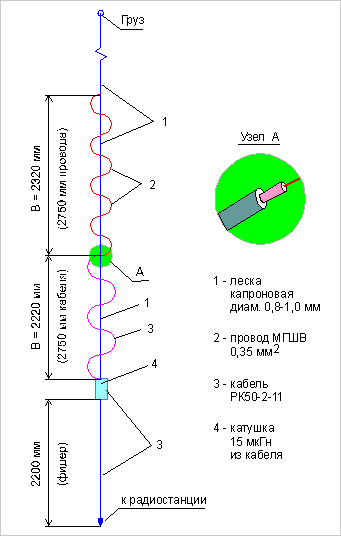In many cases, for confident communication in the range of 27 MHz is not enough short antenna Manpack radios, and the installation of efficient full-sized antenna requires too much time and money.
The most striking examples are various kinds of tourism, sports, mountaineering, Parking, camps, expeditions, hunting, different operational teams, lifeguards, maintenance radio a variety of activities on land, on water and in the air. Most often in such cases, use elongated surrogate antenna, as a rule, poorly coordinated and low profile, the effectiveness of which is small.

The proposed antenna is a slightly shortened half-wave dipole with food in the middle, made of available materials, easy to manufacture and set up.
The antenna is easily rolls up and can be quickly deployed in virtually any environment. Such an antenna can be manufactured for different ranges, but it is especially advantageous to use it in the range of 27 MHz.
The upper dipole arm (see picture) made of copper stranded wire, and used as the lower outer surface area of the outer conductor (braid) of the coaxial feeder. This area is separated electrically from.OS-the rest of the feeder coil. The arms of the dipole are of undulating shape to align with the 50-Ohm feeder. The preservation of this form is provided by a nylon line (or cable), to which the conductors of the dipole is attached at several points. The scaffold also provides for suspension of the antenna. The length of the free end of the fishing line and the length of the feeder below the coil depend on the desired height of the suspension of the antenna. Last size should not be a multiple of the half wavelength, the best value is 2.6 m or 8 m.
By the end of the fishing line tied to secure cargo that is thrown, for example, for dry wood, and then the ends of the antenna can be lifted. Around the antenna should be as much free space. By helicopter or hot air balloon antenna just overhang down. The counterweight or grounding for a radio station is not needed.
The coil is wound in the same continuous cable, which is made from the lower dipole arm and the feeder. She must have an inductance of about 15 µh, it should protect from falling between the turns of water, snow, dirt, etc is Better' to use the cable with stranded inner conductor, for example PK50-2-12 or RK50-2-16. For the upper dipole arm you can use any wire in isolation, a more or less stable at suspension. The number of "waves" of wire in the arms of the dipole are not critical. It is only important to withstand the total length of each shoulder (and N) and the length of the wires shoulders indicated in the figure in brackets.
To configure the antenna is convenient to use multi-channel radio, better with multiple grids (with a wider frequency range), and the SWR meter. Changing the size of the top of the shoulder (of a uniform stretching or compression along the length of the line without changing the length of the wire), do the configuration of the dipole to resonance at the selected frequency, and then change the size of the low-side N (without changing the length of the part of the cable in the shoulder) get minimum SWR at resonance. In this case, the resonance frequency may change, and may have the whole process done several times. After setting up firmly fasten the line shoulders with wires to prevent displacement.
The authors made according to the dimensions indicated and tested two copies of the antenna coil on a plastic cylinder with a diameter of 60 mm and a length of 80 mm, containing 19 of turns of the cable, and with the coil on the ring 65x40x6 mm ferrite brand MNN-1 - 22 spiral cable. Antenna weight without load is about 300 g. Both antennas have almost the same parameters. The panoramic SWR meter type P2-73 received SWR of 1.5 in the band 0,72 MHz and not more than 2.0 in the band 1,32 MHz at the center frequency of 27.3 MHz.
The estimated improvement in efficiency by 16 dB due to the transition from efficiency=2% helical antenna efficiency=80% of the dipole was confirmed experimentally. On level ground additional effect by increasing the height of the antenna from 1.5 to 5 m can give another 10 dB. Total gain of 26 dB is equivalent to doubling the capacity of 400 times, which can increase the communication range about 4.5 times.
Possible stationary versions of this antenna, including a rigid upper shoulder. Such antenna has been successfully used by the authors since 1994.
Authors: A. Grechikhin (UA3TZ), V. Morozkin, Nizhny Novgorod; Publication: N. Bolshakov, rf.atnn.ru






